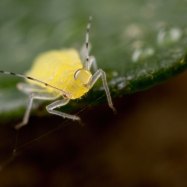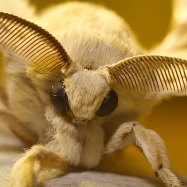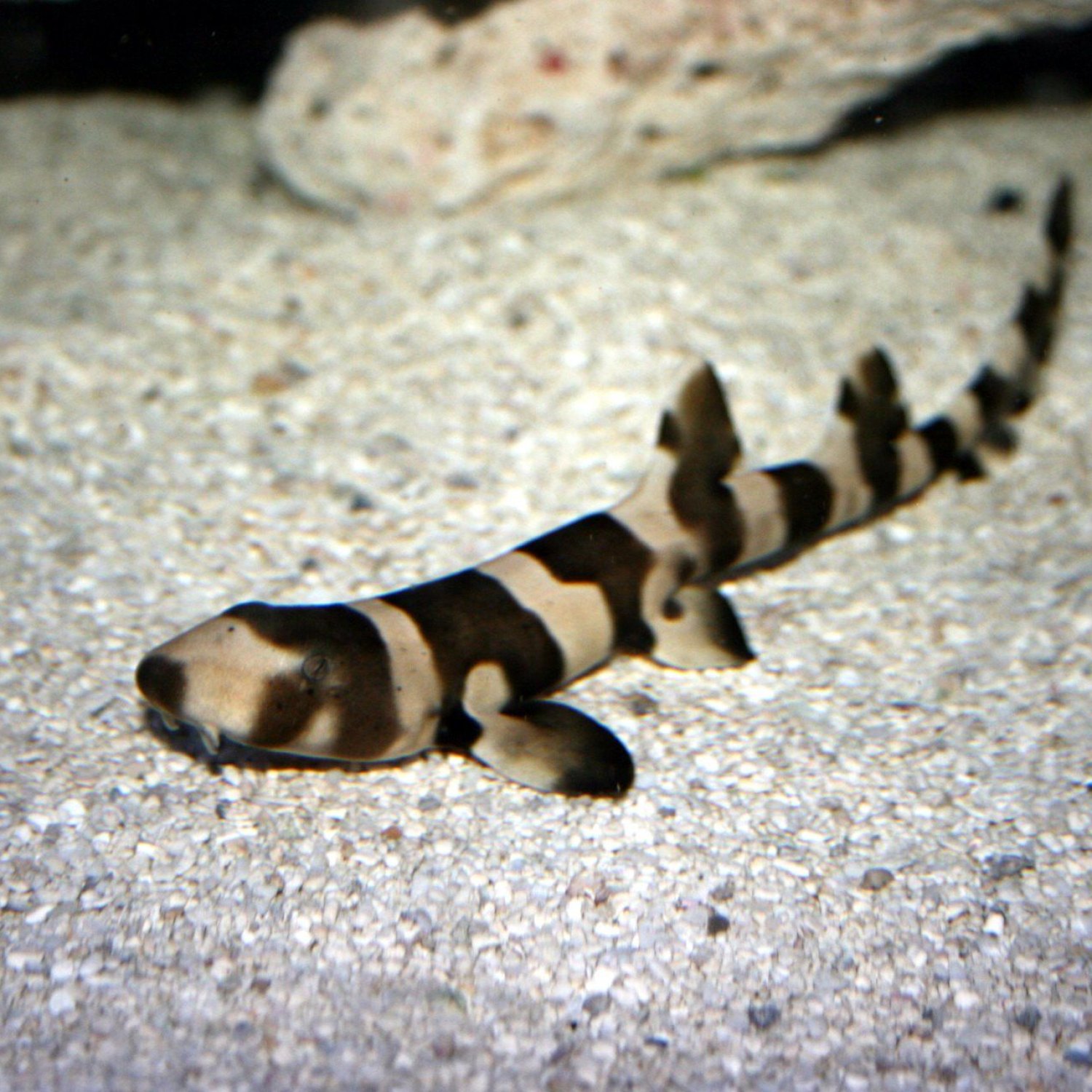
Bamboo Shark
Up to 3 feet
Bamboo sharks are fascinating creatures found in coastal regions. They belong to the Hemiscylliidae family and can grow up to 3 feet in length. Their elongated and cylindrical body shape makes them great at navigating through the ocean. Despite their name, these sharks do not eat bamboo but instead feed on small fish and crustaceans. Keep an eye out for these unique animals on your next beach trip!
Animal Details Summary:
Common Name: Bamboo Shark
Kingdom: Animalia
Habitat: Coral reefs, rocky reefs, seagrass beds, and sandy bottoms
The Secret Life of the Bamboo Shark: How the Ocean's Stealthy Hunter Flourishes
Take a dive into the mysterious world of the bamboo shark. This small but mighty creature, also known as Chiloscyllium punctatum, is a fascinating and highly adaptable species found in coastal regions of the Indo-Pacific. With its unique physical characteristics, hunting techniques, and distinct geographical distribution, the bamboo shark is a wonder of the ocean that continues to surprise researchers and enthusiasts alike.The Origins and Habitat of the Bamboo Shark
The bamboo shark belongs to the kingdom Animalia and the phylum Chordata, making it a distant cousin of other fish, reptiles, and mammals Bamboo Shark. As a proud member of the class Chondrichthyes, it shares similarities with other cartilaginous fish such as rays and skates. However, its distinct features, such as its elongated and cylindrical body shape, make it stand out in its class.These sharks thrive in diverse environments, making them a widespread species found in various countries in the Indo-Pacific region. Their habitat includes coral reefs, rocky reefs, seagrass beds, and sandy bottoms. Such a versatile habitat allows them to hunt and breed in a wide range of settings. They are particularly common in the Red Sea, East Africa, Papua New Guinea, and northern Australia.
The Physical Features of the Bamboo Shark
The bamboo shark is a small but powerful predator, capable of growing up to 3 feet in length and weighing up to 9 pounds. Their body shape, as mentioned before, is elongated and cylindrical, with a flattened head and a short snout. They also have five pairs of gill slits on the sides of their body, a characteristic typical of sharks Banded Palm Civet.One of the most distinctive features of the bamboo shark is its coloration. While their exact colors may vary, they are typically brown or gray with darker stripes or spots, making them excellent at blending into their surroundings. This unique coloration serves as a form of camouflage, allowing them to hide from potential predators and ambush their prey.
The Ferocious Hunter: Feeding Habits of the Bamboo Shark
Although relatively small in size, the bamboo shark is a fierce and efficient hunter. As a carnivorous species, they feed on a variety of prey, including crustaceans, fish, mollusks, and small sharks. Their hunting technique is a combination of stealth and speed, making them perfect hunters in their habitat.Using their specialized sensory organs, such as their lateral line system and electroreceptors, bamboo sharks can detect the slightest movements in the water. They also have excellent eyesight, enabling them to pinpoint their prey and launch a swift attack. Their cylindrical body shape and flat head make it easy for them to maneuver and chase down their prey. In some instances, these sharks have been observed using their caudal fin (tail) to stir up the sand, revealing the hiding spots of their prey.
Interestingly, bamboo sharks have the unique ability to switch between active and passive hunting techniques. During active hunting, they use their powerful jaws to grasp and consume their prey. Passive hunting, on the other hand, involves waiting patiently for their prey to come close enough for them to strike. This flexibility in their hunting strategies has made them highly effective predators in their environment.
The Fascinating World of Reproduction in Bamboo Sharks
Like many other species of sharks, bamboo sharks exhibit oviparous reproduction, meaning they lay eggs. However, what sets them apart from other species is that they are one of the few shark species that have two forms of eggs – larger, yolk-filled eggs, and smaller, yolk-less eggs. This unique adaptation assists in the survival of their offspring, as the larger eggs act as a food source for the yolk-less eggs.After a gestation period of around four months, the female bamboo shark will lay the eggs in nursery habitats, such as coral reefs, where they are less likely to be disturbed. The eggs are typically laid in pairs and are secured to the substrate using curly tendrils. This method of reproduction has proven to be highly successful in ensuring the survival of the species.
The Importance of the Bamboo Shark in its Ecosystem
Aside from their fascinating features and behavior, bamboo sharks play a crucial role in maintaining the delicate balance of their ecosystem. As apex predators, they not only regulate the population size of their prey but also prevent overgrazing of certain species on the ocean floor. They are also an essential source of food for larger predators, thus contributing to the intricate food web of the ocean.Moreover, the presence of bamboo sharks in certain habitats, such as coral reefs, is an indicator of a healthy and thriving ecosystem. It is a testament to the conservation efforts and management strategies that have been put in place to protect these environments and the species that call them home.
The Threats Facing the Bamboo Shark
Despite their adaptability and essential role in the ecosystem, bamboo sharks are facing numerous threats in the wild. One of the most significant threats is overfishing, which is driven by the high demand for their meat and fins in the shark fin soup industry. This indiscriminate harvesting of bamboo sharks has resulted in a significant decline in their population, especially in certain regions of their distribution.Moreover, as with many other marine species, the pollution of the ocean poses a severe risk to bamboo sharks. The presence of plastic waste, chemicals, and other forms of pollutants can not only harm the sharks directly but also impact their food sources and breeding habitats. It is crucial to address these threats and implement strategies to protect the bamboo shark and other marine creatures.
The Importance of Conservation Efforts for the Bamboo Shark
Fortunately, there have been significant efforts to conserve and protect the bamboo shark in recent years. Governments and organizations have implemented regulations on fishing practices and are working towards sustainable management of their habitats. Education and awareness programs also play a crucial role in promoting the conservation of the species and their environment.Furthermore, responsible ecotourism has become a vital source of income for local communities in areas where the bamboo shark is prevalent. By offering guided tours and educating visitors about the importance of protecting these creatures, communities can benefit from the conservation efforts and create a sustainable source of income.
Final Thoughts
The mysterious world of the bamboo shark continues to fascinate and captivate scientists and nature enthusiasts alike. This stealthy hunter, with its unique physical features and adaptable nature, is a testament to the wonders of evolution and the beauty of the ocean.However, with numerous threats facing their survival, it is imperative to continue efforts towards conservation and sustainable management of their habitats. By working together, we can ensure that the bamboo shark, and other marine species, continue to flourish and play their vital role in the complex ecosystem of our oceans.

Bamboo Shark
Animal Details Bamboo Shark - Scientific Name: Chiloscyllium punctatum
- Category: Animals B
- Scientific Name: Chiloscyllium punctatum
- Common Name: Bamboo Shark
- Kingdom: Animalia
- Phylum: Chordata
- Class: Chondrichthyes
- Order: Orectolobiformes
- Family: Hemiscylliidae
- Habitat: Coral reefs, rocky reefs, seagrass beds, and sandy bottoms
- Feeding Method: Carnivorous
- Geographical Distribution: Indo-Pacific, from the Red Sea and East Africa to Papua New Guinea and northern Australia
- Country of Origin: Various countries in the Indo-Pacific region
- Location: Coastal regions
- Animal Coloration: Varies, but typically brown or gray with darker stripes or spots
- Body Shape: Elongated and cylindrical
- Length: Up to 3 feet
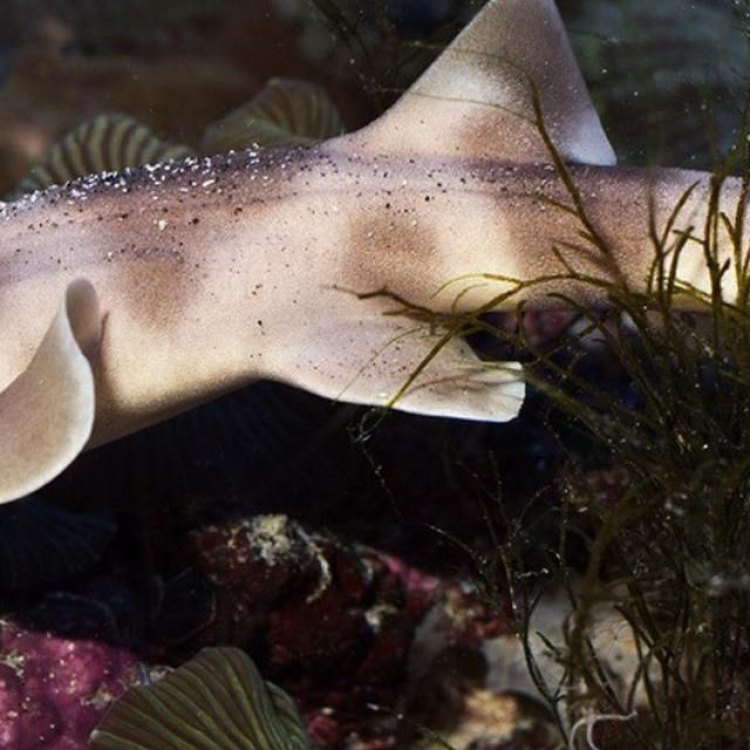
Bamboo Shark
- Adult Size: 2.5 to 3 feet
- Average Lifespan: 20 to 25 years
- Reproduction: Oviparous (lays eggs)
- Reproductive Behavior: Males court females and fertilization is internal
- Sound or Call: Not known to make sounds or calls
- Migration Pattern: No regular migration patterns
- Social Groups: Solitary
- Behavior: Nocturnal and sedentary
- Threats: Habitat destruction, overfishing, and collection for the aquarium trade
- Conservation Status: Near Threatened
- Impact on Ecosystem: Important role in maintaining the balance of reef ecosystems
- Human Use: Collected for the aquarium trade
- Distinctive Features: Long, flattened head; small mouth located on the underside of the head
- Interesting Facts: Bamboo Sharks are also known as cat sharks due to their slender, cat-like bodies.
- Predator: Larger sharks and predatory fish
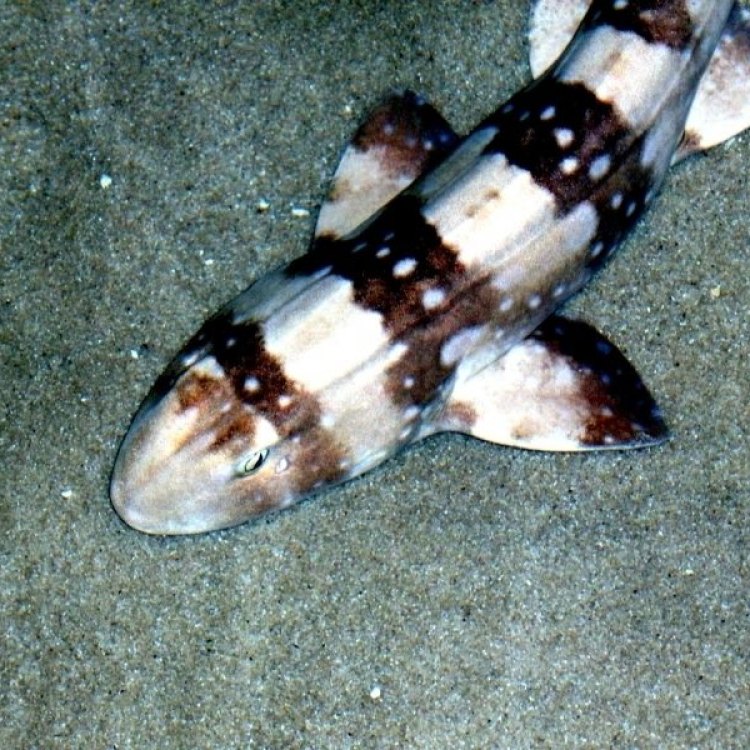
Chiloscyllium punctatum
The Mysterious Bamboo Shark: A Hidden Treasure of the Ocean
The ocean is a vast and wondrous place, full of diverse and fascinating creatures. Some are well-known and admired, while others remain hidden and mysterious. One such creature is the Bamboo Shark.The Bamboo Shark, also known as the Cat Shark, is a species of shark that belongs to the Hemiscylliidae family PeaceOfAnimals.Com. They are found in shallow waters near coral reefs, rocky areas, and mangroves, primarily in the Indo-Pacific region. These unique sharks have been able to capture the attention of marine biologists, diver enthusiasts, and aquarium owners due to their distinctive features and intriguing behavior.
This article will delve into the rare and intriguing features of the Bamboo Shark, its behavior, and its role in maintaining the balance of reef ecosystems.
Appearance and Distinctive Features
The adult size of a Bamboo Shark ranges from 2.5 to 3 feet, making it a relatively small species compared to other sharks. Their slender, cat-like bodies give them their nickname of Cat Sharks. They have five pairs of gill slits, two spineless dorsal fins, and a long, flattened head. The most notable feature is the small mouth located on the underside of their head, which is used for bottom-feeding on small fishes, crustaceans, and mollusks.One of the most striking features of the Bamboo Shark is its unique coloration Bismarck Ringed Python. They have a beautiful and intricate pattern of dark brown, grey, and yellow markings, making them stand out in their natural environment. This coloration also acts as excellent camouflage, helping them blend into the sandy and rocky ocean floor. It also enables them to sneak up on unsuspecting prey.
Reproduction and Behavior
Bamboo Sharks are oviparous, which means they lay eggs instead of giving birth to live young. Females lay around 20 to 30 eggs in a leathery egg case, commonly known as a mermaid's purse. These egg cases have curly tendrils on each corner, allowing them to attach to rocks and corals, keeping them safe until they hatch.The reproductive behavior of Bamboo Sharks is quite fascinating. Males will court females through elaborate dances and rituals, which includes biting and trailing their snouts along the females' bodies. Once the female signals she is ready to mate, the male will use his claspers to implant sperm internally, leading to fertilization and the release of eggs.
Bamboo Sharks are solitary creatures, which means they do not form social groups. They are mostly nocturnal, meaning they are most active during the night, and lead mostly sedentary lives, only venturing out in search of food.
Threats and Conservation Status
Unfortunately, like many other marine creatures, Bamboo Sharks face numerous threats. The destruction of their natural habitat, particularly coral reefs and mangrove forests, is a significant issue. Habitat destruction disrupts their food sources, breeding grounds, and shelter. Overfishing has also posed a threat to their population, as they are often caught as bycatch in fishing nets, or specifically targeted for their meat and fins.Furthermore, Bamboo Sharks are also collected and sold for the aquarium trade. Due to their small size and unique appearance, they are in high demand for home aquariums and public exhibits. The capture and transportation process can be harmful and often leads to the death of these fragile creatures.
According to the International Union for Conservation of Nature (IUCN), Bamboo Sharks are considered "Near Threatened," with their population declining due to these various threats. Several organizations and initiatives are working towards preserving and protecting their natural habitats and raising awareness about the importance of conserving this unique species.
Role in the Ecosystem
Despite their small size, Bamboo Sharks play a crucial role in maintaining the balance of reef ecosystems. As bottom-feeders, they help control the population of small fishes, crustaceans, and mollusks, preventing overconsumption and maintaining a healthy balance. Their presence also acts as an indicator of a healthy reef ecosystem, as their disappearance can signal the decline of other species that depend on them for food and shelter.Human Use and Interesting Facts
As mentioned earlier, Bamboo Sharks are often collected for the aquarium trade. However, it is essential to understand that these creatures are not ideal for captivity. They require specific water conditions, need enough space to move around, and do not thrive in a solitary environment. Keeping them in captivity often leads to stress, illness, and ultimately, death.Apart from their use in the aquarium trade, there are also a few interesting facts about the Bamboo Sharks. While most sharks are known for their infamous sounds and calls, studies have shown that Bamboo Sharks are not known to make any sounds. They are also popular among divers for their docile nature and lack of aggression towards humans, making them safe to interact with in the wild.
Predators
As with any creature in the ocean, Bamboo Sharks have their share of predators. Larger sharks and predatory fish such as tuna and groupers are known to prey on them. However, they have developed a defense mechanism to protect themselves from these threats. When threatened, they can curl up into a ball and wedge themselves between rocks and coral crevices, making it difficult for predators to reach them.Final Thoughts
The Bamboo Shark may not be as famous as its bigger and more infamous counterparts, but its unique features and behavior make it a fascinating and mysterious creature of the ocean. From its distinctive coloration to its innovative reproductive behavior, this species has captured the attention of researchers, divers, and aquarium enthusiasts alike.However, it is crucial to remember and understand the threats faced by Bamboo Sharks and the importance of conserving their natural habitats. As stewards of the ocean, it is our responsibility to ensure that these magnificent creatures continue to thrive in their natural environment for generations to come. With proper education and conservation efforts, we can help protect and preserve this hidden treasure of the ocean.
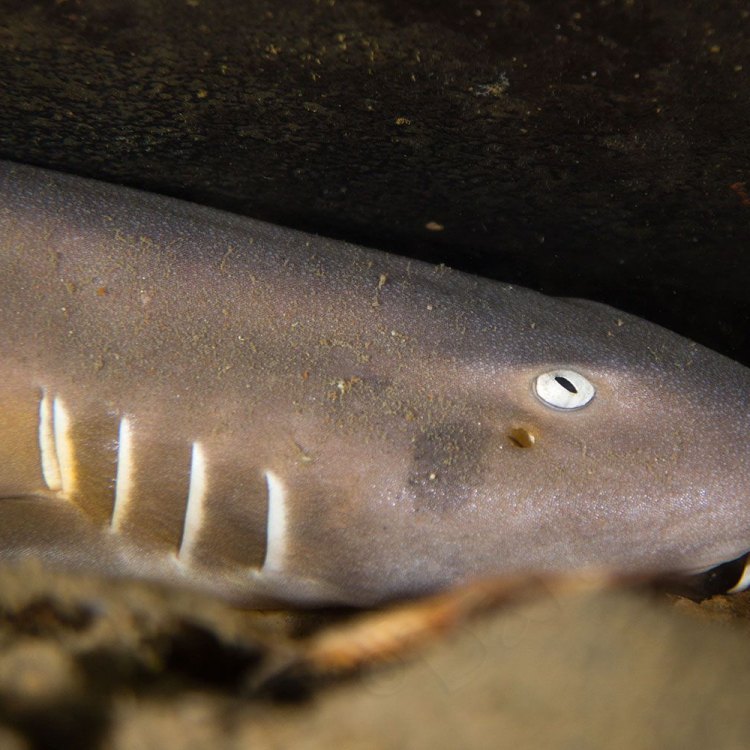
The Secret Life of the Bamboo Shark: How the Ocean's Stealthy Hunter Flourishes
Disclaimer: The content provided is for informational purposes only. We cannot guarantee the accuracy of the information on this page 100%. All information provided here may change without prior notice.






